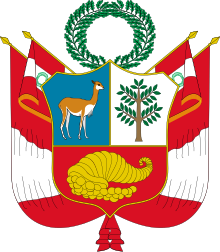Republic of Northern Peru
The Republic of Northern Peru (Spanish: República Nor-Peruana ) was one of the three republics of the short-lived Peruvian-Bolivian Confederation . It existed from 1836 to 1839. The capital was Lima .
history
The state came into being as a result of the Bolivian occupation of Peru. For example, the Bolivian President Andrés de Santa Cruz stood behind the Peruvian Caudillo Luís Orbegoso in the fight against Agustín Gamarra and Felipe Santiago de Salaverry and used the military support to occupy large parts of Peru. On August 15, 1836, Santa Cruz invaded Lima . In preparation for a Peruvian-Bolivian confederation, he had the political structure of Peru reorganized and divided the country into two republics. On March 17, 1836, the Republic of Southern Peru was founded under General Ramón Herrera Rodado from the four southern provinces of Peru. The remaining provinces united on August 6, 1836 in Huánuco under the government of Luís de Orbego to form the Republic of Northern Peru. This comprised about 2/3 of the area of Peru in the borders before 1836 and had a population of 700,000–830,000 inhabitants. On October 28, 1836, northern Peru united with southern Peru and Bolivia to form the Confederación Perú-Boliviana. During the Peruvian-Bolivian Confederate War , Luís Orbegoso unilaterally declared the independence of northern Peru from the confederation on July 30, 1838, but did not withdraw from the war against Chile. The Republic of Northern Peru was finally dissolved on August 25, 1839 with the dissolution of the confederation and the declaration of the renewed independence of the reunited Peru. The Peruvian General Agustín Gamarra was elected President on February 24th.
President of the Republic of Northern Peru
- General Luis Orbegoso (August 21, 1837 - July 30, 1838, Provisional President until September 1, 1838)
- General José de la Riva Agüero (August 1, 1838 - February 24, 1839)
Territorial division
Northern Peru consisted of the four northern provinces of Peru before 1836. This territorial division was retained later. Contemporary literature occasionally mentions only three provinces, as the Amazonas province (called Pampas ) was almost unexplored by Europeans and almost exclusively inhabited by indigenous people.
| # | Department | Department population |
Capital | Population capital |
|---|---|---|---|---|
| 1 | Amazon ( Pampas ) | 250,000 | ? | ? |
| 2 | Lima | 149.112 | Lima | 70,000 |
| 3 | Junín | 201,259 | Tarma | 5,000-10,000 |
| 4th | La Libertad | 230.967 | Trujillo | 12,000-14,000 |
literature
- Heraclio Bonilla: Peru and Bolivia from Independence to the War of the Pacific , in: Leslie Bethell (ed.): The Cambridge history of Latin America , Vol. 3, Cambridge 2002, pp. 539-582.
- Herbert S. Klein: A concise history of Bolivia , Cambridge 2003, pp. 89–117.
- Robert L. Scheina: Latin America's Wars: The age of the caudillo 1791-1899 , Vol. 1, Dulles 2003, pp. 132-139.
Individual evidence
- ↑ a b c d Cf. Samuel Augustus Mitchell: Mitchell's geographical reader: a system of modern geography , Philadelphia 1840, p. 227.
- ↑ a b cf. trade almanac or overview of what is worth knowing for trade in the various countries of the world , Weimar 1838, p. 852.
- ↑ a b c Cf. Ludwig Gottfried Blanc: Handbook of the most worth knowing from the nature and history of the earth and its inhabitants , Braunschweig 1858, p. 569.




